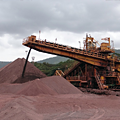HOW DOES MINING EQUIPMENT WORK IN IRON ORE MINING?
June 28, 2017
Iron ore mining shapes the world. The raw ferrous deposits are extracted and transformed into structural steel, machine housings, case hardened gears and countless other important products. Without iron alloys, contemporary buildings couldn’t rise towards the sky, nor could heavy-duty equipment support the massive loads that iron girders manage every working day. Given those facts, how does mining equipment extract iron ore?
SCALING THE MATERIAL RIGIDITY LADDER
Before considering any other factor, think about how the steel backbone in a primary crusher handles the feed stream. The extracted iron ore is heavy and sharp-edged, so the equipment that processes that aggregate must be fabricated from materials that are at least as hard. In point of fact, ferrous equipment alloys are manufactured from high-grade steel. In most cases, amalgamated carbon and iron deliver the metal fortitude, then they’re further post-processed until they’re imbued with an incredibility durable frame.
EXTRACTING IRON OXIDES
Far along the equipment chain, a relatively soft brown ore is being drilled and blasted from the mine face. Hematite and limonite, magnetite and goethite, the mining operation is extracting the rock and crushing it until the rocky deposits are evenly sized. Remember, the deposits are somewhat soft, even crumbly, but there’s raw iron trapped inside the ore. Given time, the ore will age the mining equipment, deform the system parts, and hamstring process productivity. The rollers and crushers will be the first to go, followed by the screening media and the reciprocating motors that power the vibratory screening decks. Top-tier mining equipment stops this scenario from becoming a system-handicapping reality.
PREVENT IRON ORE ABRASION
A fighting-fire-with-fire maxim works well in this extractive process, especially when the iron-toughened equipment is heat treated and alloyed. That’s not quite enough, though, is it? The toughest rigid metals do still warp when a high-volume barrage is flowing in the ore stream. The second half of the mining equipment solution is to line the metal housings with an elastomeric coating. Tough engineering plastics absorb abrasive damage, then pass the shock harmlessly into the metal frame, where it’s distributed as process noise.
Iron ore processing calls up a whole proprietary range of extractive gear. That primary crusher now has a secondary stage. The ore is recycled and crushed again, then it’s passed forward to a grinding station, so the iron ore is continually being ground down into rock and iron oxide. Represented on an iron ore flowchart, the crushers and grinders pair with magnetic rollers and other electronic separators. Other separation mechanisms in the process include wet and dry grinders, agitation tanks, and elevated vibrational screening decks.
Optimized by: Netwizard SEO


